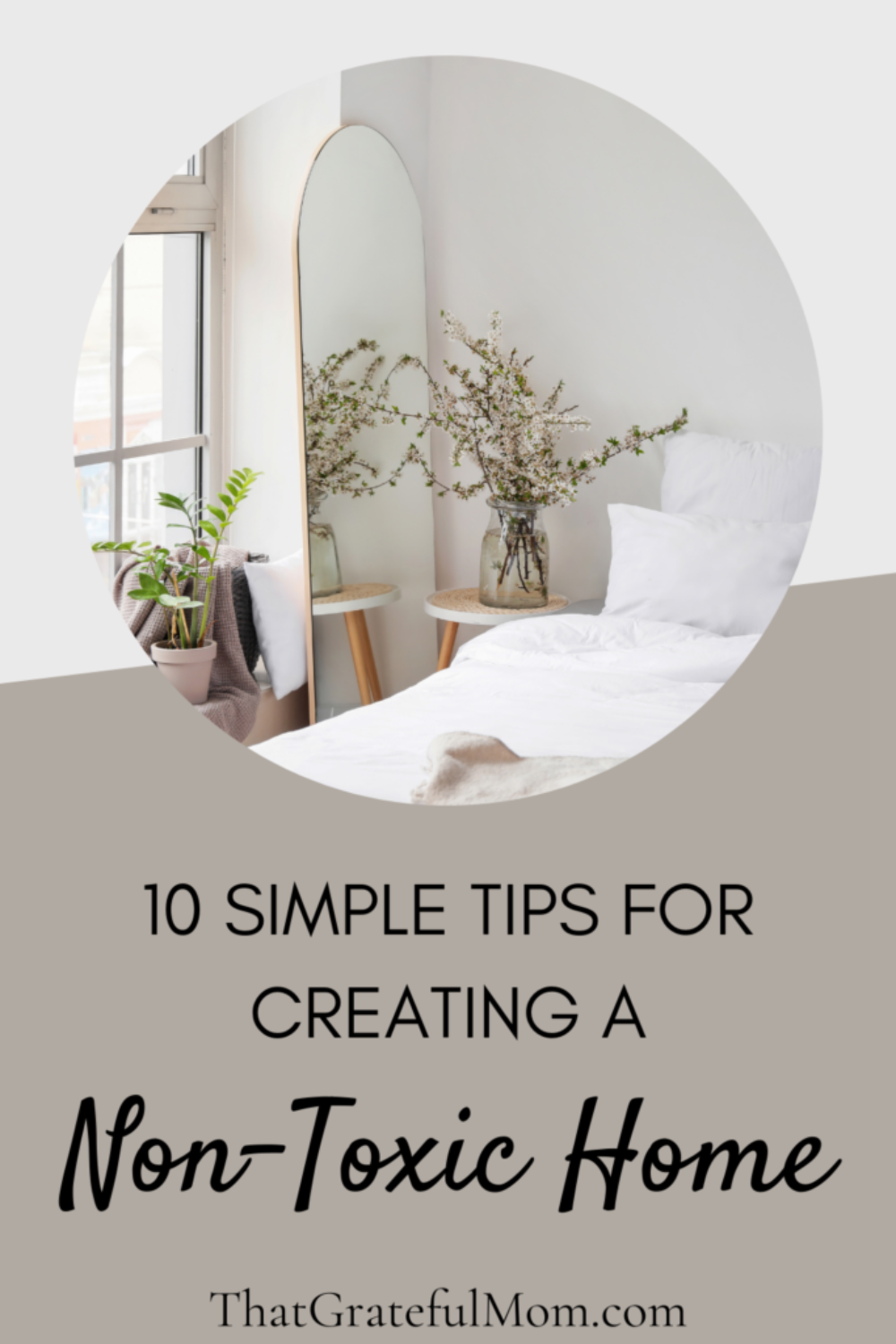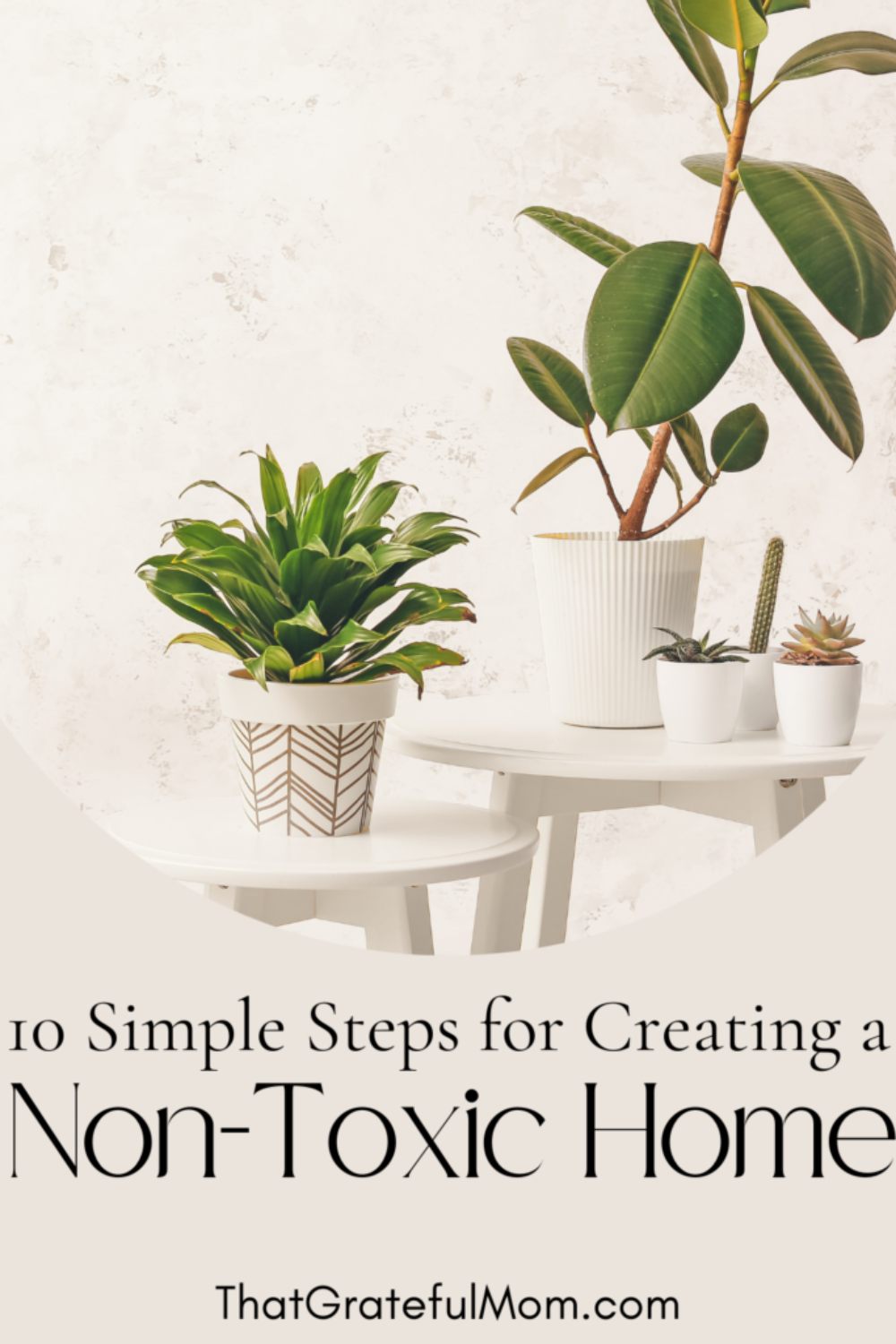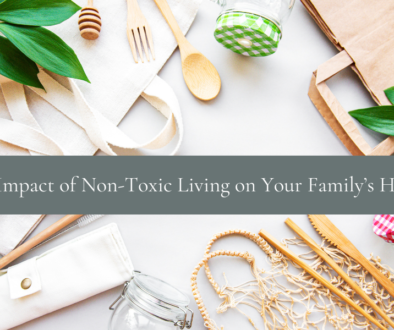10 Simple Steps for Creating a Non-Toxic Home
Creating a safe and healthy living environment is more important than ever with all the toxic chemicals and harmful substances found in personal care products, cleaning supplies, and even our water supply. Creating a non-toxic home provides a sanctuary for you and your loved ones, free from harmful chemicals and pollutants that can affect your health and well-being. In today’s post, I’m sharing simple yet effective tips for transforming your space into a toxin-free home, covering everything from common toxins to DIY cleaning recipes. In no time, you’ll be a pro at spotting non-toxic products, making your own cleaning products, and creating a non-toxic home on any budget.
As a mom of six, including a child who’s faced health issues like childhood cancer and asthma, we’ve worked tirelessly over the last 4 years to embrace a toxic-free lifestyle without depleting our savings in the process. I’ve learned how to replace household products, make my own cleaning supplies and laundry detergent, and shop for organic foods while sticking to a strict budget.
As a one-income home, it hasn’t been easy, but we’ve stuck to our weekly budget of $200 for groceries and toiletries and learned how to choose safer products for a healthier home. I share everything I’ve learned along the way with you, so you don’t have to do this alone! When I was first researching alternatives, I was incredibly overwhelmed. I had no idea just how many harmful ingredients I was unknowingly exposing our family to or where to begin making changes.
Every week, I share a new post on non-toxic living, budget-friendly swaps, and simple ways to make changes in your home that have a positive impact on your health.
Here are some of my recent posts:

Building a non-toxic home
It can be difficult to know where to begin when creating a non-toxic home. Toxic materials and heavy metals have been found in over 90% of the US water supply, making it unsafe to even drink unfiltered water. It shouldn’t be this way, but unfortunately, it’s difficult to hold anyone accountable for these situations when there are little to no repercussions for using toxic chemicals or improperly disposing of them.
The best way to protect yourself from these harmful toxins is to become your own advocate and research everything you can. Learn about important chemicals to avoid, choose non-toxic cleaning products and non-toxic options, and do the best you can to protect your health because no one else is going to do it for you.
As a rule of thumb, we aim for an 80/20 balance in our home. 80% non-toxic products, 20% conventional. As much as I’d love to be 100% toxin-free, it’s not realistic. There’s no such thing as a chemical-free home, and striving for perfection leaves everyone disappointed.
We have non-negotiables we follow and refuse to budge on, but I’m not going to lose sleep if my kids are at a birthday party and have a slice of cake with bright blue frosting or someone gifts me a candle that made them think of me. I know to make my own frosting for a cake and buy fragrances with essential oils instead of synthetic ingredients, but I don’t expect everyone to live the way I do and follow the same guidelines.
I firmly believe that being in a constant state of stress is just as hard on our health as using toxic items and maintaining balance is important. Don’t sweat the small stuff.
Creating a non-toxic home by avoiding harmful chemicals
It’s important to become familiar with toxic chemicals that are commonly used in household cleaners, personal care products, and genetically modified foods. A healthy home environment is achievable, but reducing your exposure to these harmful ingredients will reduce the likelihood of developing health problems caused by these chemicals.
While this list is not exhaustive, these commonly used chemicals are harmful and should be avoided as much as possible.
Volatile organic compounds (VOCs)
Commonly found in paint, new furniture, gas, pesticides, and some cleaning supplies, these toxic substances are known to cause irritation of the eyes, nose, and throat, respiratory distress, damage to the liver and kidneys, and some types are linked to cancer.
Phthalates
One of the most concerning chemicals commonly found in household products is phthalates. These chemicals are often used to enhance the flexibility and durability of plastics, making them prevalent in various items such as vinyl flooring, shower curtains, fragrance products, cleaning supplies, and even beauty products. However, research has linked phthalates to endocrine disruption, infertility, birth defects, and some cancers.
Sodium Lauryl Sulfate
SLS and SLES are surfactants commonly found in cleaning agents, shampoos, and soaps due to their foaming properties. However, these chemicals can strip the skin and hair of their natural oils, leading to dryness and irritation. Furthermore, during the manufacturing process, SLS and SLES can be contaminated with a carcinogenic compound called 1,4-dioxane.
Parabens
Parabens are preservatives widely used in cosmetics, personal care products, and even some food items to prevent the growth of bacteria and fungi. However, research has indicated that parabens can mimic estrogen in the body and potentially disrupt hormonal balance. Some studies have also linked parabens to breast cancer. When shopping for household products, including personal care items, choose those labeled as “paraben-free” or opt for natural preservatives like grapefruit seed extract or vitamin E.
PFAs
PFAs help make products water-resistant. Items like shoes, tents, flooring, and stains often contain PFAs. Unfortunately, they’ve also been found in makeup products and over half of our water supply in the US. Health risks include low birth weight, risk of cancers, and more.
Formaldehyde
Formaldehyde is a colorless gas with a strong, pungent odor that is widely used in the manufacture of numerous household products. It can be found in cleaning agents, furniture, carpets, and even personal care items. Prolonged exposure to formaldehyde can cause respiratory problems and skin irritation, and the International Agency for Research on Cancer (IARC) has classified it as a human carcinogen. If we can use the chemical for embalming, we probably shouldn’t be exposing ourselves to it in our personal care products.
Habits to embrace for creating a non-toxic home
Avoiding synthetic fragrances
The word ‘fragrance’ is often used to describe over 500 possible chemicals. Because companies are not forced to disclose what chemicals they are using in their products, avoiding synthetic fragrances is crucial. Health issues include headaches, dizziness, neurological distress, PCOS, breast cancer, and reproductive harm.
As much as we love our homes to smell inviting and cozy, indoor air quality really takes a hit when you use air fresheners and candles with harsh toxins. You are contributing to indoor air pollution. An effective way to avoid this is by using air fresheners with natural ingredients like essential oils and candles made from beeswax instead of soy or paraffin, which most conventional candles contain.
Best non-toxic air freshener for your home

These alternatives to conventional air fresheners offer all the inviting fragrances we love without compromising the progress you’ve made toward embracing a non-toxic lifestyle!
Beeswax candles
I love beeswax candles, as they are safer than conventional candles and actually help improve indoor air quality. These are the best brands available, using 100% pure essential oils and clean beeswax.
Essential oil diffuser
Using a diffuser with your favorite essential oils is an excellent alternative to candles. Because there’s no fire, it’s much safer than candles, and many diffusers offer a timer, so you don’t have to worry about remembering to turn it off.
Young Living offers beautiful diffusers perfect for every room in your home. My favorite is the Aria diffuser.
Alternatively, Amazon offers quite a few diffusers and essential oil brands. Just ensure they’re reputable and clean, as many brands are toxic and contain harmful ingredients.
Simmer pot
If you’d prefer to skip essential oils or candles, simmer parts are customizable and add moisture to the air as they boil. Add sliced citrus fruit, cinnamon, vanilla, or any combination of scents you enjoy most, and let it simmer! The only downside to simmer pots is remembering to turn off your stove before leaving the house or heading to bed for the evening.
Open your windows!
One of the simplest things you can do when creating a non-toxic home is to open your windows! It’s free, welcomes fresh air, and reduces the harmful chemicals roaming your house. Indoor air is dirtier and contains around 2-5 times more pollutants than outdoor air. Indoor air pollution is a serious concern that is linked to dozens of health issues like allergies, headaches, brain fog, and more. Throw those windows open a few times a day for a positive impact on your health.
Invest in an air purifier
Your household furnishings, tables, chairs, flooring, pressed wood, synthetic fragrances, and household cleaning products contain chemicals that continue to float in the air in your home because it has no way to escape. Invest in an air purifier if opening windows isn’t practical due to weather or other issues. There are excellent, affordable options that can remove up to 99.97% of airborne dust, mold, bacteria, viruses, and other harmful substances.
Here are some of my favorite brands:
While pricey, it’s worth it. Airdoctor offers multiple sizes perfect for every living space, and their air filters last 6 months at least, making them an excellent option for larger families.
more affordable than Airdoctor and offered in multiple sizes, Levoit is an excellent option. The only downside is that we found the filters needed to be replaced much more frequently than expected.
Creating cleaner air in your home is an effective way to embrace a toxic-free lifestyle without spending much money on new products.

Bonus tip:
Invest in house plants! Many are easy to maintain, regenerate the air in your home, and help purify it cheaply! Plants are excellent natural air purifiers if purchasing an air purifier is out of your budget. Some types to consider are snake, pothos, and spider plants, but check with your vet if you have pets to ensure they’re safe for your home.
Swap out plastic for glass or stainless steel.
While plastic may be easier to transport, when heated in a microwave, it breaks down and releases harmful chemicals into our food. Even the highest quality brands have chemicals like phthalates and BPAs. Yes, even plastic containers labeled ‘BPA Free’ can have BPS, which is even more toxic than BPAs! Ridiculous, right? You’re being tricked into thinking BPA-free means it’s a safer option when, in reality, it’s still toxic.
Once you swap plastic for glass containers, you’ll wonder why you didn’t do it sooner. I can heat it in the oven or even in the microwave. (Yes, we still use our microwave sometimes!) Investing in glass initially is a bit more expensive, but it doesn’t break down, warp, or release any questionable ingredients when you heat it. Investing in higher-quality brands makes the glass thicker and won’t break when dropped.
Here are a few good options:
Additionally, skip the zip-loc bags for reusable options like beeswax wraps when glass isn’t an option!
Take your shoes off.
This one should be common knowledge, but it’s still not! Think about it for a second, though. You run to the grocery store, stop and get gas, maybe pick up lunch somewhere, and then head home. Or maybe you work somewhere that has you walking a lot during the day. You walk in the door, drop the mail on the counter, head to your room for a second, and you don’t take your shoes off at the door. Now, all those places that your shoes touched have entered your home! You have no idea what happened in those places before you go there. Instead of risking it, slip your shoes off at the door and become a no-shoe household! Less dirt, dust, and fear of unknowingly tracking in something harmful.
Invest in a good water filter.
Like the air, our water supply contains contaminants like chlorine, bleach, toxic waste, pharmaceuticals, and volatile organic compounds (VOCs). And while the city may filter it, it’s filtered using more chemicals, making our water quality questionable at best. This tip is probably the most expensive on the list today, but it’s worth it. With how much we use water to cook, clean, and bathe ourselves, we must consider what we use in our homes. Here are some of my favorite suggestions for clean water filters. If a whole home filter is out of the question, at least consider a filter for your cooking and drinking water source.
Toss the microwave.
For many families, this tip will be one of the tougher decisions. And it’s okay if you’re not there yet! Creating a non-toxic home and embracing non-toxic living is a journey. Save this post for later when you’re ready for more. When you are ready to toss the microwave, you’ll be shocked at how simple it can be. I love my air fryer and toaster oven. Both make reheating food easy and fast without zapping your food to high heaven. Some are lined with Teflon, which is unhealthy, but finding a brand without the nonstick layer is simple enough. Cuisinart is one of my favorite brands and goes on sale often to help you save some cash.

Ditch the nonstick.
Speaking of nonstick, pots and pans coated in Teflon or similar nonstick materials are made from chemicals like perfluoroalkyl and polyfluoroalkyl substances that, when heated, release toxic fumes into the air. While some health organizations claim no harmful side effects are caused by using nonstick surfaces, if scratched, heated too high, or damaged, it can cause respiratory harm, thyroid damage, infertility, and more.
Instead of nonstick cookware, opt for healthier options like cast iron, ceramic, or stainless steel. When used properly, stainless steel works just as well as nonstick cookware without the harsh chemicals. Not sure how to prevent foods from sticking to your nonstick pans? This post will show you exactly how to do it!
Final thoughts
If you’re working on creating a non-toxic home, I am so glad you’ve taken the first steps! I know it can seem overwhelming at first, but once you start researching alternatives and making changes, you’ll soon realize how simple it can be to create a healthy home environment and choose non-toxic options!
It’s okay to take things slow and make one change at a time. Whether you choose to focus on finding non-toxic products, purchasing organic foods, or cleaning up indoor air, you’re making incredible changes in your home that make a huge difference. Be proud of that, and don’t get discouraged!
Thanks so much for being here. Let me know in the comments below if you have any questions!
This site may contain links to affiliate websites including Amazon. I may receive an affiliate commission for any purchases made by you through Amazon or other potential affiliates and no additional cost to you. Thank you for your support.








May 8, 2024 @ 5:21 pm
From simple swaps to in-depth explanations of harmful chemicals to avoid, I love that this post covers it all! Fantastic resource for anyone starting their journey toward a non-toxic lifestyle. Great job!??
May 8, 2024 @ 6:22 pm
I’ve been in the process of creating a low-tox home for quite some time now and totally agree with all you have outlined in this post. Aiming for an 80/20 lifestyle is realistic as there are times we can’t control the environment. Making the switch to toxin-free skincare and makeup has been my latest task and I’m happy to have found a product line that is toxin-free and high-performing. Thanks for sharing!
May 15, 2024 @ 3:02 pm
This is just pure common sense and yet we don’t realise the kind of rubbish we bring in to our homes! Thank you for the reminder!